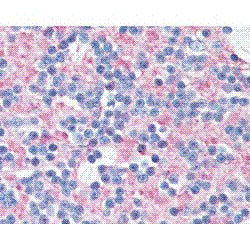SNAP-25 antibody | SP12

Mouse anti Human SNAP-25
- Product Type
- Monoclonal Antibody
- Clone
- SP12
- Isotype
- IgG1
- Specificity
- SNAP-25
| Mouse anti Human SNAP-25 antibody, clone SP12 recognizes the human pre-synaptic protein, SNAP-25, also known as Synaptosomal-associated protein 25, Super protein (SUP) or Synaptosomal-associated 25 kDa protein. SNAP-25 is a 206 amino acid presynaptic protein of ~25 kDa containing two t-SNARE coiled-coil homology domains. Mouse anti human SNAP-25 antibody, clone SP12 will recognize SNAP-25 fusion protein from COS cells, but not the fusion protein from bacterial systems. Mouse anti Human SNAP-25 antibody, clone SP12 has been used to study the distribution of synaptic changes in the hippocampus of patients with medically refractory temporal lobe epilepsy. (Honer et al. 1994). |
- Target Species
- Human
- Species Cross-Reactivity
-
Target Species Cross Reactivity Hamster Pig Rat Gerbil - N.B. Antibody reactivity and working conditions may vary between species.
- Product Form
- Purified IgG - liquid
- Preparation
- Purified IgG prepared by affinity chromatography on Protein A from tissue culture supernatant
- Buffer Solution
- Phosphate buffered saline
- Preservative Stabilisers
- 0.09% sodium azide (NaN3)
- Carrier Free
- Yes
- Immunogen
- Crude human synaptic immunoprecipitate.
- Approx. Protein Concentrations
- IgG concentration 1.0 mg/ml
- Fusion Partners
- Spleen cells from immunised BALB/c mice were fused with cells of the NSO myeloma cell line.
- Regulatory
- For research purposes only
- Guarantee
- 12 months from date of despatch
Avoid repeated freezing and thawing as this may denature the antibody. Storage in frost-free freezers is not recommended.
| Application Name | Verified | Min Dilution | Max Dilution |
|---|---|---|---|
| ELISA | |||
| Immunohistology - Paraffin | 1/2000 | 1/5000 | |
| Western Blotting | 1/500 | 1/5000 |
- Histology Positive Control Tissue
- Brain
Source Reference
-
Honer, W.G. et al. (1989) Monoclonal antibodies to study the brain in schizophrenia.
Brain Res. 500 (1-2): 379-83.
References for SNAP-25 antibody
-
(2011) Human Protein Atlas: CAB000360
Human Protein Atlas: CAB000360 -
Honer, W.G. et al. (1992) Regional synaptic pathology in Alzheimer's disease.
Neurobiol Aging. 13 (3): 375-82. -
Honer, W.G. et al. (1992) Characterization of a synaptic antigen of interest in neuropsychiatric illness.
Biol Psychiatry. 31 (2): 147-58. -
Honer, W.G. et al. (1993) Human synaptic proteins with a heterogeneous distribution in cerebellum and visual cortex.
Brain Res. 609 (1-2): 9-20. -
Wakabayashi, K. et al. (1994) Synapse alterations in the hippocampal-entorhinal formation in Alzheimer's disease with and without Lewy body disease.
Brain Res. 667 (1): 24-32. -
Dickson, D.W. et al. (1994) Hippocampal sclerosis: a common pathological feature of dementia in very old (≥80 years of age) humans.
Acta Neuropathol. 88 (3): 212-21. -
Lemons, P.P. et al. (1997) Regulated secretion in platelets: identification of elements of the platelet exocytosis machinery.
Blood. 90: 1490-500. -
Steel, G.J. et al. (1997) Evidence for interaction of the fusion protein alpha-SNAP with membrane lipid.
Biochem J. 325 : 511-8.
View The Latest Product References
-
Reed, G.L. et al. (1999) Human platelets contain SNARE proteins and a Sec1p homologue that interacts with syntaxin 4 and is phosphorylated after thrombin activation: implications for platelet secretion.
Blood. 93: 2617-26. -
Mukaetova-Ladinska, E.B. et al. (2000) Staging of cytoskeletal and beta-amyloid changes in human isocortex reveals biphasic synaptic protein response during progression of Alzheimer's disease.
Am J Pathol. 157: 623-36. -
Vannucchi, M.G. et al. (2000) Synapse formation during neuron differentiation: an in situ study of the myenteric plexus during murine embryonic life.
J Comp Neurol. 425: 369-81. -
Ishimaru, H. et al. (2001) Changes in presynaptic proteins, SNAP-25 and synaptophysin, in the hippocampal CA1 area in ischemic gerbils.
Brain Res. 903: 94-101. -
Sawada, K. et al. (2002) Altered immunoreactivity of complexin protein in prefrontal cortex in severe mental illness.
Mol Psychiatry. 7: 484-92. -
Bragina, L. et al. (2006) GLT-1 down-regulation induced by clozapine in rat frontal cortex is associated with synaptophysin up-regulation.
J Neurochem. 99: 134-41. -
Chen, H.Y. et al. (2009) Melatonin improves presynaptic protein, SNAP-25, expression and dendritic spine density and enhances functional and electrophysiological recovery following transient focal cerebral ischemia in rats.
J Pineal Res. 47: 260-70.
MCA1308
If you cannot find the batch/lot you are looking for please contact our technical support team for assistance.
Please Note: All Products are "FOR RESEARCH PURPOSES ONLY"
View all Anti-Human ProductsAlways be the first to know.
When we launch new products and resources to help you achieve more in the lab.
Yes, sign me up